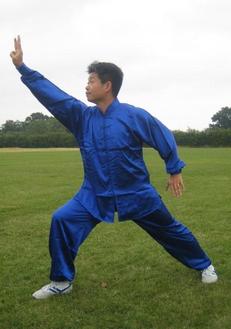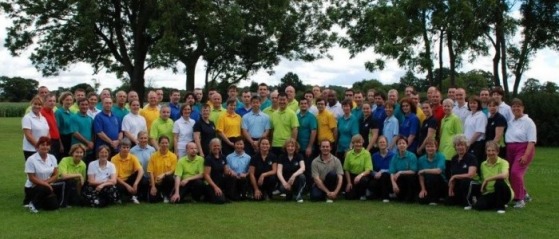Wild Goose (Dayan) Qigong
What is Qigong?
Qigong is a traditional Chinese health exercise made up of movements that connect with the acupuncture points and channels of the body. Qigong literally means 'energy work'. When these special movements are practised along with relaxation and breathing, then we have Qigong.
Practising Qigong helps us to relax and become more aware of our bodies. Over time, we begin to notice changes including being more flexible, and an increase in energy and stamina. This is because the Qi is working to heal any old illnesses or injuries and to open the channels so that the Qi can flow naturally, making us feel younger and more healthy.
There are many types and styles of Qigong. The style taught by the Tse Qigong Centre is called the Kunlun Dayan (Wild Goose) Qigong system.
 Learning Wild Goose Qigong 1st 64
Learning Wild Goose Qigong 1st 64
History
The Kunlun Dayan Qigong system originated over 1800 years ago in the Kunlun Mountains, Tibet. Daoist monks lived in these mountains in retreat from ordinary society, hoping to cultivate longevity and enlightenment. Living so closely with nature allowed the monks to observe the creatures around them and how they survived in what was often a harsh and forbidding climate.
One of these creatures was the Dayan, literally 'Big Wild Goose'. These birds, also known as Bar Headed Geese, are quite extraordinary as they are able to fly at a very high altitude due to their ability to process oxygen in a unique way. They also live longer than other geese species.
When the monks began to imitate these beautiful, long life birds, they found many benefits. The fluttering released toxins from the body's channels while the swooping, bending and stretching movements stimulated the waist and kidneys, creating warmth and flexibility. Over time, as the skill expanded and developed, they found that it even developed their Sky Eye potential, helping to develop wisdom.
Lineage

Master Michael Tse and Grandmaster Yang Meijun
The Kunlun Dayan Qigong system is available to us now because of an incredible lady; Great Grandmaster Yang Meijun who was the 27th generation inheritor of the skill. Though she was taught the skills by her Grandfather from the age of 13 years, she promised him that she would not teach until she reach 70 years. In fact, due to difficult times in China, Great Grandmaster Yang Meijun did not start teaching until well after her 70th birthday. Great Grandmaster Yang Meijun, known throughout the world as one of the most famous Qigong masters, reached the age of 104 years before passing away in 2002.
Grandmaster Michael Tse

Master Michael Tse
One of Great Grand Master Yang Meijun's students was Grandmaster Michael Tse and with her blessing he brought the skill to the west.
In 1990, the Tse Qigong Centre was established in England and from that time, many people have benefited from Grandmaster Tse's commitment to passing on this profound skill.
In 1990, the Tse Qigong Centre was established in England and from that time, many people have benefited from Grandmaster Tse's commitment to passing on this profound skill.
What will I learn in class?
When students come to class, they are guided through a syllabus of Qigong forms at a manageable pace.
The first form students learn in class is Balancing Gong. It incorporates simple movements that form the basis of their learning. It helps students to establish relaxation, good posture and natural breathing techniques. Balancing Gong is good for circulation, flexibility and balance as well as helping arthritis, backache, joint problems and co-ordination.
Healthy Living Gong is the next set of movements and these are divided into three parts. The first part is concerned with relaxation and balance; the second part focuses on fitness and coordination while the third part helps to improve our physical strength as well as developing more powerful Qi (energy).
When students have completed Balancing Gong and Healthy Living Gong they will progress to Wild Goose (Dayan) Qigong. This form is a series of connected movements and there are two parts to it. The 1st 64 movements works with postnatal Qi and can help with healing of illnesses and old injuries acquired since birth. The 2nd 64 set of movements works with prenatal Qi and can help with inherited illnessess or weaknesses, like heart disease and diabetes.
After learning Wild Goose Qigong, students are able to learn other forms of the Kunlun Dayan Qigong system, each with its own special emphasis on certain parts of the body. For example, the next form in the syllabus is Swimming Dragon Gong and this is particular good for the kidneys using lots of circular movements and creating strong bone Qi from the one legged stances.
"The subtleties and sophistication of the Kunlun Dayan Qigong system enables students to continually work towards deeper levels of understanding, appreciation and enjoyment. I believe the system delivers a manageable, quality health regime second to none". Belinda
The first form students learn in class is Balancing Gong. It incorporates simple movements that form the basis of their learning. It helps students to establish relaxation, good posture and natural breathing techniques. Balancing Gong is good for circulation, flexibility and balance as well as helping arthritis, backache, joint problems and co-ordination.
Healthy Living Gong is the next set of movements and these are divided into three parts. The first part is concerned with relaxation and balance; the second part focuses on fitness and coordination while the third part helps to improve our physical strength as well as developing more powerful Qi (energy).
When students have completed Balancing Gong and Healthy Living Gong they will progress to Wild Goose (Dayan) Qigong. This form is a series of connected movements and there are two parts to it. The 1st 64 movements works with postnatal Qi and can help with healing of illnesses and old injuries acquired since birth. The 2nd 64 set of movements works with prenatal Qi and can help with inherited illnessess or weaknesses, like heart disease and diabetes.
After learning Wild Goose Qigong, students are able to learn other forms of the Kunlun Dayan Qigong system, each with its own special emphasis on certain parts of the body. For example, the next form in the syllabus is Swimming Dragon Gong and this is particular good for the kidneys using lots of circular movements and creating strong bone Qi from the one legged stances.
"The subtleties and sophistication of the Kunlun Dayan Qigong system enables students to continually work towards deeper levels of understanding, appreciation and enjoyment. I believe the system delivers a manageable, quality health regime second to none". Belinda

